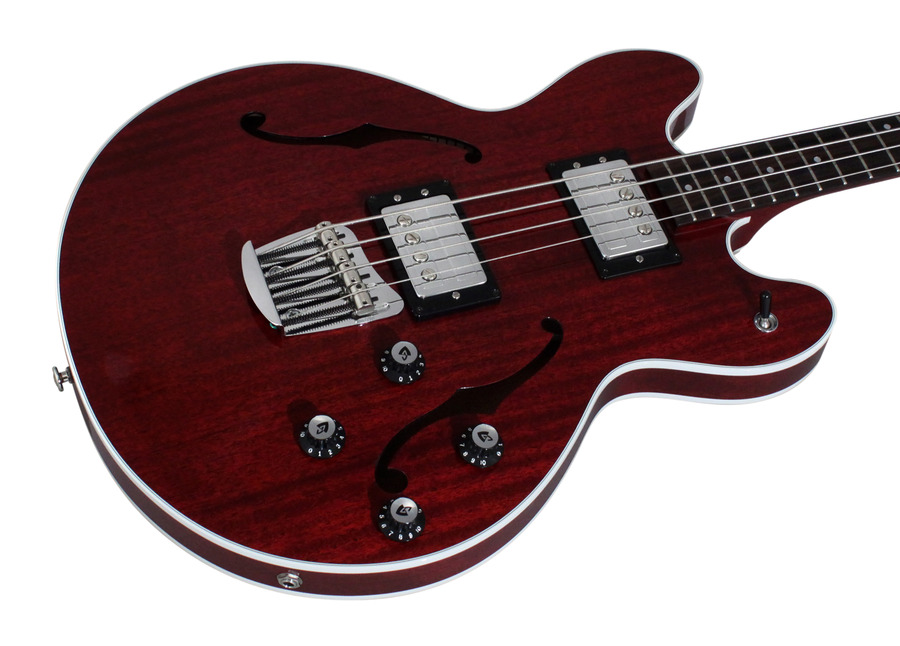
Stable tuning and easy adjustability are provided by the Tune-o-matic bass bridge, and the harp tailpiece adds a touch of Guild's classic aesthetic, likening the bass to its upright ancestors. Featuring a slimmed down, 2.4" body thickness, inward-shifted neck, short 30 ¾" scale length, and a 1 ½" nut width, the Starfire I Bass is a compact and accessible option for younger players, or those who want more freedom on stage. Excellent - Condition.Guild's Starfire I Bass is a modern adaptation of the traditional Starfire Bass platform. With a very straight neck, good angle and only minimal fret wear it is a truly excellent player, perhaps not the cleanest Starfire bass we have had (though not beat up looking either) but one of the nicest to play. This bass remains all original, and except for its cosmetic scarring on the back still a very good looking bass. The neck finish is worn through smoothly over some of its surface. The top shows several spots of wear near the fingerrests, and a couple of scrapes behind the bridge. The majority of the finish overall is well preserved with good rich cherry color and only small chips and dings, but there is one large area of belt buckle wear on the back through the finish into the wood, and someone attempted to sand around it leaving the edges smooth but deeply scuffed. This bass is in excellent structural and playing condition with some play wear but no repairs or alterations. (4.6 cm.) in depth, measured at side of rim. The tuners are the typical American-made Klusons, also used by Gibson. The top has small plastic fingerrests on either side of the strings-the earliest versions were wooden. The chrome Hagstrom bridgeplate is asymmetrical, extended on the treble side for better intonation and to look more like Guild's traditional "harp" tailpiece. With the bright-sounding Bi-Sonic this electronic choke was not particularly needed but Guild followed the Gibson pattern and added it anyway. There is a pushbutton "baritone" switch that was added soon after the single pickup was moved closer to the neck- the earliest Starfire basses had the single P.U. This Starfire I has newer features that were added over the course of 1967. This bass is the quintessential 1960's example with cherry-red lacquer over striped "Sapeli" mahogany that was originally the defining "Starfire" finish. This particular Starfire I is from 1967,the peak production year for these basses with over 1,000 units shipped from Hoboken. With magnet slugs nearly 1/4" wide for polepieces, this pickup has a very powerful attack and a broad harmonic range quite unlike either the familiar Gibson EB bass humbucker or the later Guild humbucking pickup which replaced it in 1970. Still, the real secret to the early Guild basses' unique sound is the huge Hagstrom-made Bi-Sonic pickup, which looks like a double-coil unit but is in fact more akin to a giant DeArmond Dynasonic. Unlike most 1960's basses the body is not fully hollow, there is a solid block running through the center in the manner of an ES-335 (and EB-2) giving a tighter response than a true hollowbody bass.


The solid body Jetstar Bass quickly crashed and burned but the Starfire Bass soon became one of the company's most popular items. Guild did not offer any electric bass until 1965, when the semi-hollow Starfire line and the solidbody line both had a single-pickup bass added. With an unusually slim and very fast-playing neck the Starfire is the perfect bass to "take off" on and remains as unique as when first designed. Other early prominent users of the model were Steve Boone of the Lovin' Spoonful (who had the first two-pickup model built for him) and Chris Hillman with the Byrds. Starfire basses became a prominent part of the San Francisco sound in the late 60's with both Phil Lesh of the Grateful Dead and Jack Casady of the Jefferson Airplane choosing the model for their psychedelic explorations of the low end. Despite a general resemblance to the more common Gibson EB-2/Epiphone Rivoli line the Starfire is a completely different animal sonically, putting out a very clear and powerful sound with a wide frequency range and almost piano-like growl unusual in a hollowbody bass. One of our most requested instruments, the 1960's Guild Starfire bass has in recent years gained renewed attention as one of that decade's most distinctive bass guitars. Guild Starfire Bass Model Semi-Hollow Body Electric Bass Guitar (1967), made in Hoboken, NJ, cherry lacquer finish, laminated mahogany body and neck, rosewood fingerboard, original black tolex hard shell case.


 0 kommentar(er)
0 kommentar(er)
